sensor FORD FIESTA 2007 Workshop Manual
[x] Cancel search | Manufacturer: FORD, Model Year: 2007, Model line: FIESTA, Model: FORD FIESTA 2007Pages: 1226, PDF Size: 61.26 MB
Page 926 of 1226
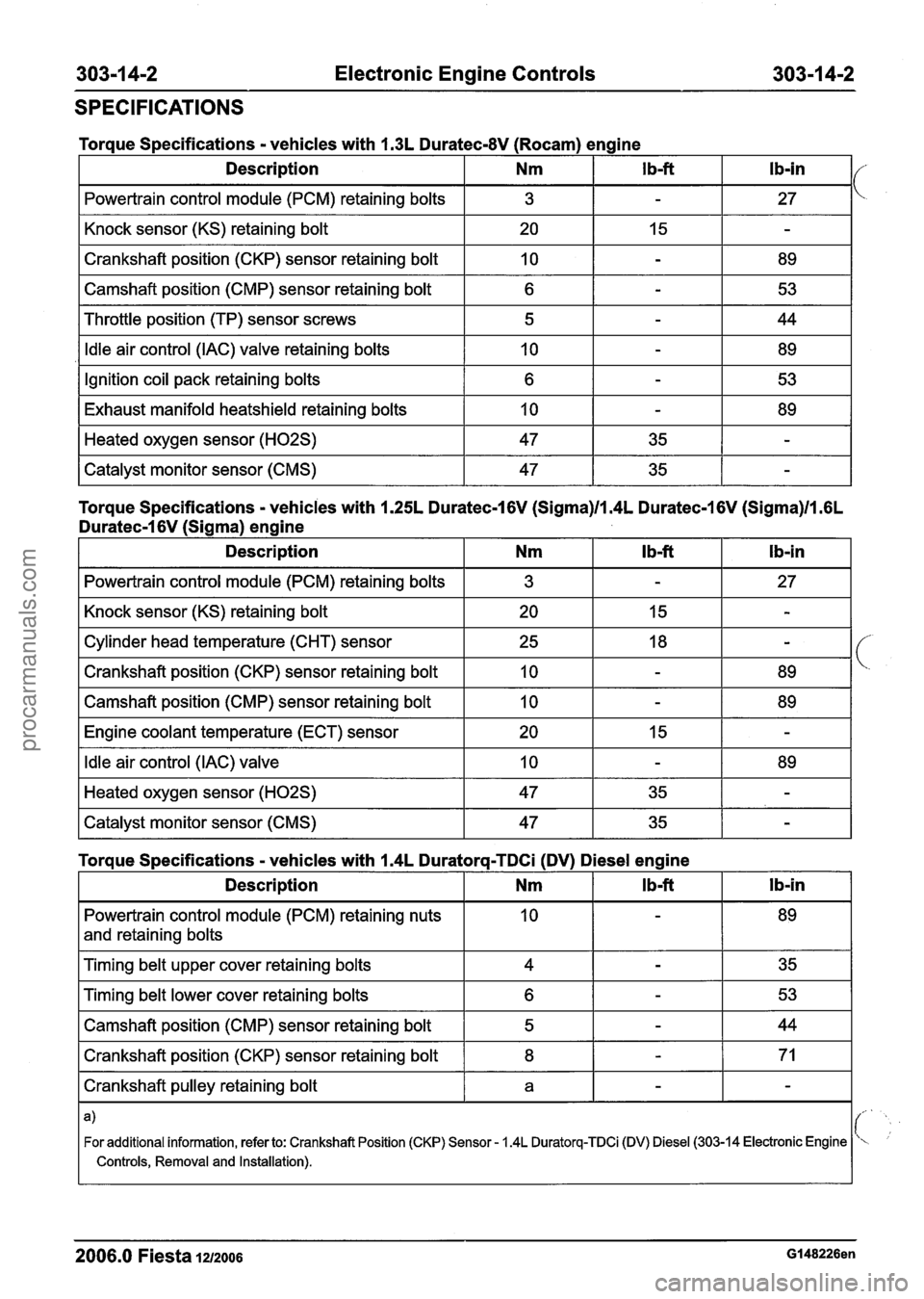
303-1 4-2 Electronic Engine Controls 303-1 4-2
SPECIFICATIONS
I Powertrain control module (PCM) retaining bolts I 3 I - I 27 I
Torque Specifications - vehicles with 1.3L Duratec-8V (Rocam) engine
I Knock sensor (KS) retaining bolt I 20 I 15 I - I
Description
I Crankshaft position (CKP) sensor retaining bolt I 10 I - I 89 I
I Camshaft position (CMP) sensor retaining bolt I
I Throttle position (TP) sensor screws I 5 I - I 44 I
Ib-in I/ Nm
I Idle air control (IAC) valve retaining bolts I 10 I - I 89 I
I b-ft
Ignition coil pack retaining bolts
Exhaust manifold heatshield retaining
bolts
Torque Specifications - vehicles with 1.25L Duratec-1 6V (Sigma)ll.4L Duratec-1 6V (Sigma)ll .6L
Duratec-I 6V (Sigma) engine
Heated oxygen sensor (H02S)
Catalyst monitor sensor (CMS)
I Powertrain control module (PCM) retaining bolts I 3 I - I 27 I
6
10
I Knock sensor (KS) retaining bolt I 20 I 15 I - I
47
47
-
-
I Camshaft position (CMP) sensor retaining bolt I 10 I - I 89 I
53
89
35
35
Cylinder head temperature (CHT) sensor
Crankshaft position (CKP) sensor retaining bolt
I Engine coolant temperature (ECT) sensor I 20 I 15 I - I
-
-
I Idle air control (IAC) valve I 10 I - I 89 I
25
10
I Heated oxygen sensor (H02S) I 47 I 35 I - I -- --
I Catalyst monitor sensor (CMS) 47 I 35 1 - I
18
-
-
89
Powertrain control module (PCM) retaining nuts
and retaining bolts
Torque Specifications - vehicles with 1.4L Duratorq-TDCi (DV) Diesel engine
1 Timing belt upper cover retaining bolts I 4 I - I 35 I
I Timing belt lower cover retaining bolts I 6 I - I 53 I
l b-in
Description
I Camshaft position (CMP) sensor retaining bolt I 5 I - I 44 I
I Crankshaft position (CKP) sensor retaining bolt I 8 I - I 71 I
Nm
I Crankshaft pulley retaining bolt I a I - I - I
I b-ft
I- .
For additional information, refer to: Crankshaft Position (CKP) Sensor - 1.4L Duratorq-Ci D) Diesel (303-14 Electronic Engine ''
I Controls, Removal and Installation).
2006.0 Fiesta 1212006 Gl48226en
procarmanuals.com
Page 927 of 1226
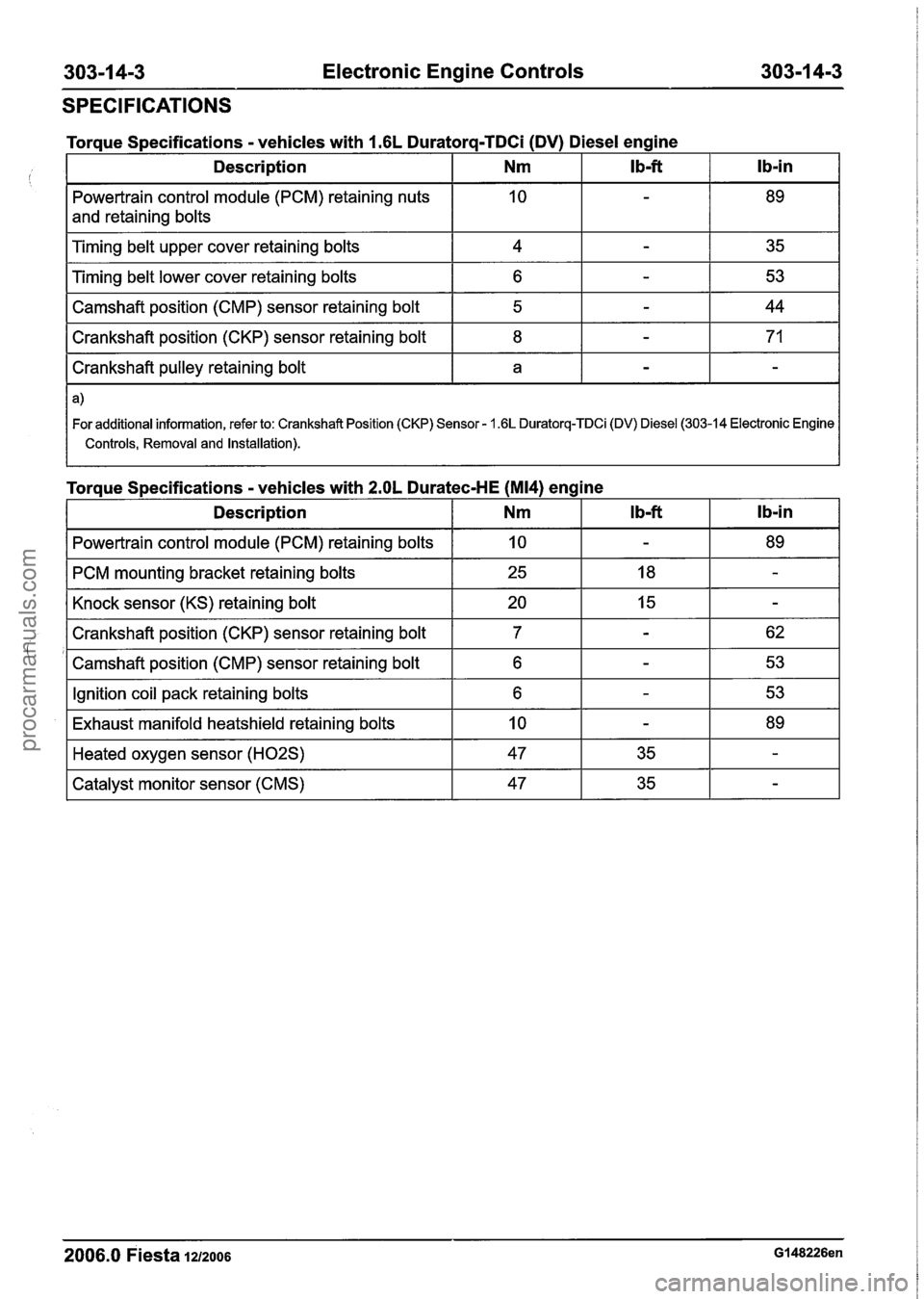
303-1 4-3 Electronic Engine Controls 303-1 4-3
SPECIFICATIONS
control module (PCM) retaining nuts
and retaining bolts
Torque
Specifications
- vehicles with 1.6L Duratorq-TDCi (DV) Diesel engine
I Camshaft position (cMP) sensor retaining bolt I 5 I - I 44 I
lb-in
Timing belt upper cover retaining bolts
Timing belt lower cover retaining bolts
I Crankshaft position (CKP) sensor retaining bolt I 8 I - I 71 I
Ib-ft Description
I Crankshaft pulley retaining bolt I a I - I - I
Nm
4
6
I For additional information, refer to: Crankshaft Position (CKP) Sensor - 1.6L Duratorq-TDCi (DV) Diesel (303-14 Electronic Engine I
I Controls, Removal and Installation). I
-
-
Torque Specifications - vehicles with 2.OL Duratec-HE (M14) eng 35
53
I Description I Nm
ine
I Powertrain control module
(PCM) retaining bolts I 10 I - I 89 I
I PCM mounting bracket retaining bolts I 25 I 18 I - I
I Knock sensor (KS) retaining bolt I 20 I 15 I - I
I Crankshaft position (CKP) sensor retaining bolt I 7
'1 Camshaft position (CMP) sensor retaining bolt I 6
I Ignition coil pack retaining bolts I 6 I - I 53 I
I Exhaust manifold heatshield retaining bolts I 10 I - I 89 I
2006.0 Fiesta 1212006 GI 48226en
-- -
Heated oxygen sensor (H02S)
Catalyst monitor sensor (CMS) 47
47
35
35
-
-
procarmanuals.com
Page 929 of 1226

303-1 4-5 Electronic Engine Controls 303-1 4-5
DESCRIPTION AND OPERATION
Item Description Item Description
2006.0 Fiesta 1212006 G204204en
I 1 I Temperature and Manifold Absolute
2 3 1 Knock Sensor (KS)
pressure (T-MAP) sensor
Throttle Position (TP) sensor
4 Sensor - Engine Coolant Temperature
(ECT)
procarmanuals.com
Page 930 of 1226
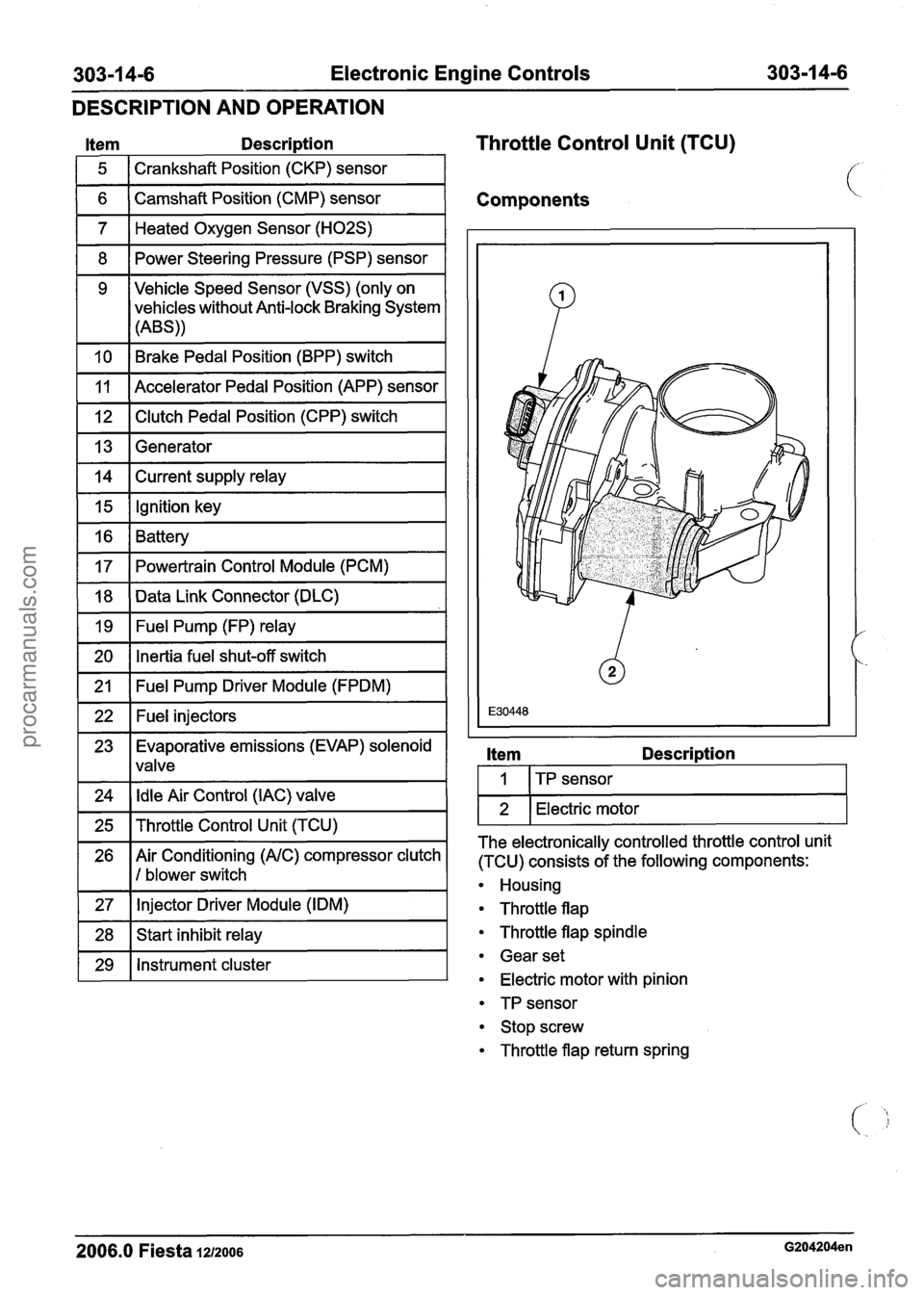
303-1 4-6 Electronic Engine Controls 303-1 4-6
DESCRIPTION
AND OPERATION
Item Descri~tion
1 5 1 Crankshaft Position (CKP) sensor 1
Throttle Control Unit (TCU)
1 6 ( Camshaft Position (CMP) sensor I Components
1 7 1 Heated Oxygen Sensor (H02S) I
1 8 1 Power Steering Pressure (PSP) sensor I
1 10 1 Brake Pedal Position (BPP) switch I
9 Vehicle Speed Sensor (VSS)
(only on
vehicles without Anti-lock Braking System
(ABS))
1 12 1 Clutch Pedal Position (CPP) switch I
11
1 13 1 Generator I
Accelerator Pedal Position (APP) sensor
1 14 1 Current supply relay I
1 15 1 Ignition key I -
16
17
1 20 1 Inertia fuel shut-off switch I
Battery
Powertrain Control Module (PCM)
-
18
19
1 21 1 Fuel Pump Driver Module (FPDM) I
Data Link Connector (DLC)
Fuel Pump (FP) relay
1 22 1 Fuel injectors I
23 Evaporative emissions (EVAP) solenoid
1 lvalve
1 24 1 Idle Air Control (IAC) valve 1
1 25 1 Throttle Control Unit (TCU) I
26 Air Conditioning (AIC) compressor clutch
1 I 1 blower switch
1 27 1 Injector Driver
Module (IDM) I
1 28 1 Start inhibit relay I
1 29 1 Instrument cluster I
Item Descri~tion
I I ITP sensor I
1 2 1 Electric motor I
The electronically controlled throttle control unit
(TCU) consists of the following components:
Housing
Throttle flap
Throttle flap spindle
Gear set
Electric motor with pinion
TP sensor
Stop screw
Throttle flap return spring
2006.0 Fiesta 1212006 G204204en
procarmanuals.com
Page 931 of 1226
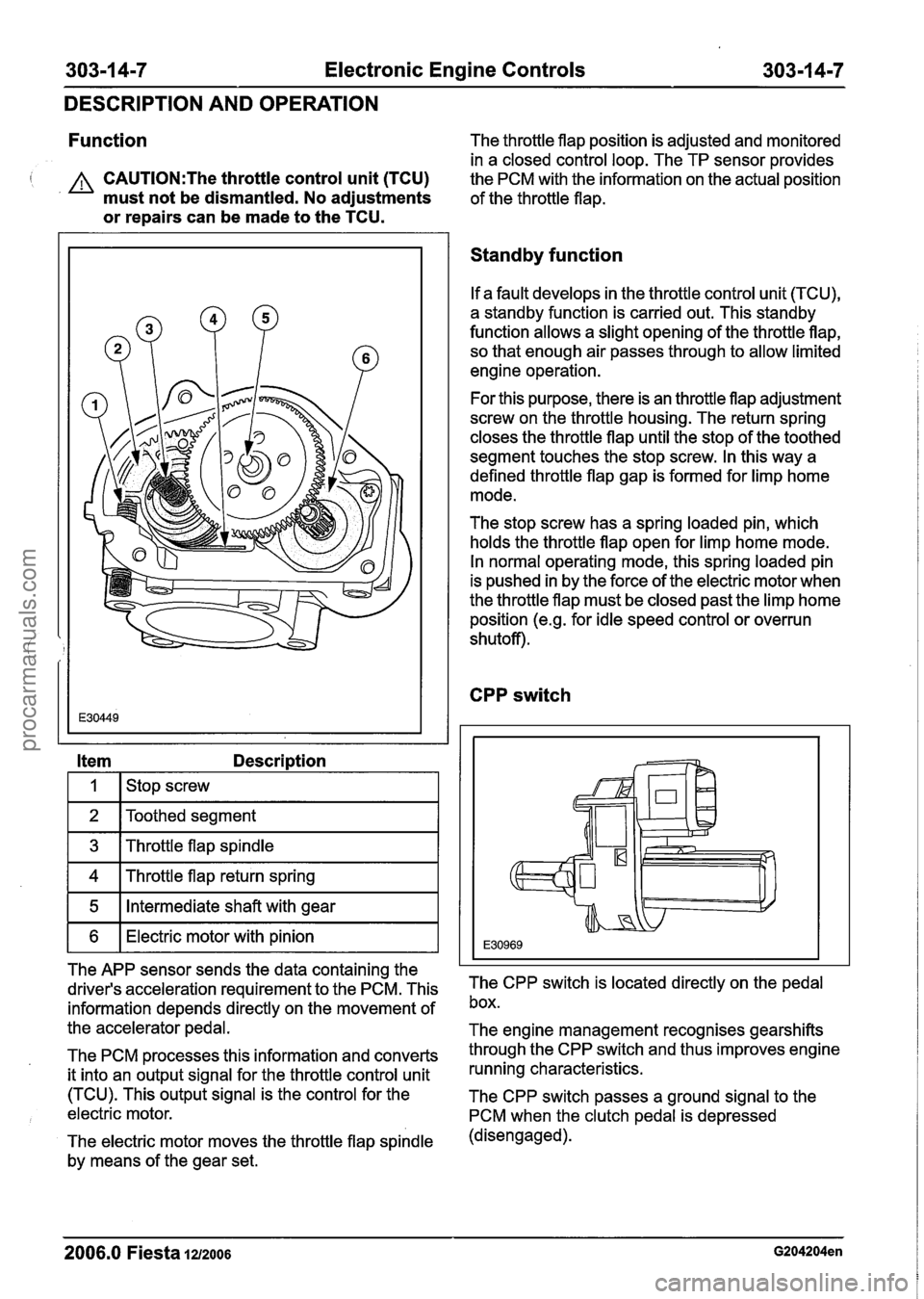
303-1 4-7 Electronic Engine Controls 303-1 4-7
DESCRIPTION AND OPERATION
Function The throttle flap position is adjusted and monitored
in a closed control loop. The TP sensor provides
I A CAUTI0N:The throttle control unit (TCU)
the PCM with the information on the actual position
must not be dismantled. No adjustments
of the throttle flap.
or repairs can be made to the TCU.
Item Description
I I I stop screw I
1 2 IToothed segment I
1 3 1 Throttle flap spindle I
1 4 1 Throttle flap return spring I
1 5 1 Intermediate shaft with gear I
1 6 1 Electric motor with pinion I
The APP sensor sends the data containing the
driver's acceleration requirement to the PCM. This
information depends directly on the movement of
the accelerator pedal.
The PCM processes this information and converts
it into an output signal for the throttle control unit
(TCU). This output signal is the control for the
electric motor.
The electric motor moves the throttle flap spindle
by means of the gear set.
Standby function
If a fault develops in the throttle control unit (TCU),
a standby function is carried out. This standby
function allows a slight opening of the throttle flap, so that enough air passes through to allow limited
engine operation.
For this purpose, there is an throttle flap adjustment
screw on the throttle housing. The return spring
closes the throttle flap until the stop of the toothed
segment touches the stop screw. In this way a
defined throttle flap gap is formed for limp home
mode.
The stop screw has a spring loaded pin, which
holds the throttle flap open for limp home mode.
In normal operating mode, this spring loaded pin
is pushed in by the force of the electric motor when
the throttle flap must be closed past the limp home
position
(e.g. for idle speed control or overrun
shutoff).
CPP switch
The CPP switch is located directly on the pedal
box.
The engine management recognises gearshifts
through the CPP switch and thus improves engine
running characteristics.
The CPP switch passes a ground signal to the
PCM when the clutch pedal is depressed
(disengaged).
2006.0 Fiesta 1212006 G204204en
procarmanuals.com
Page 932 of 1226
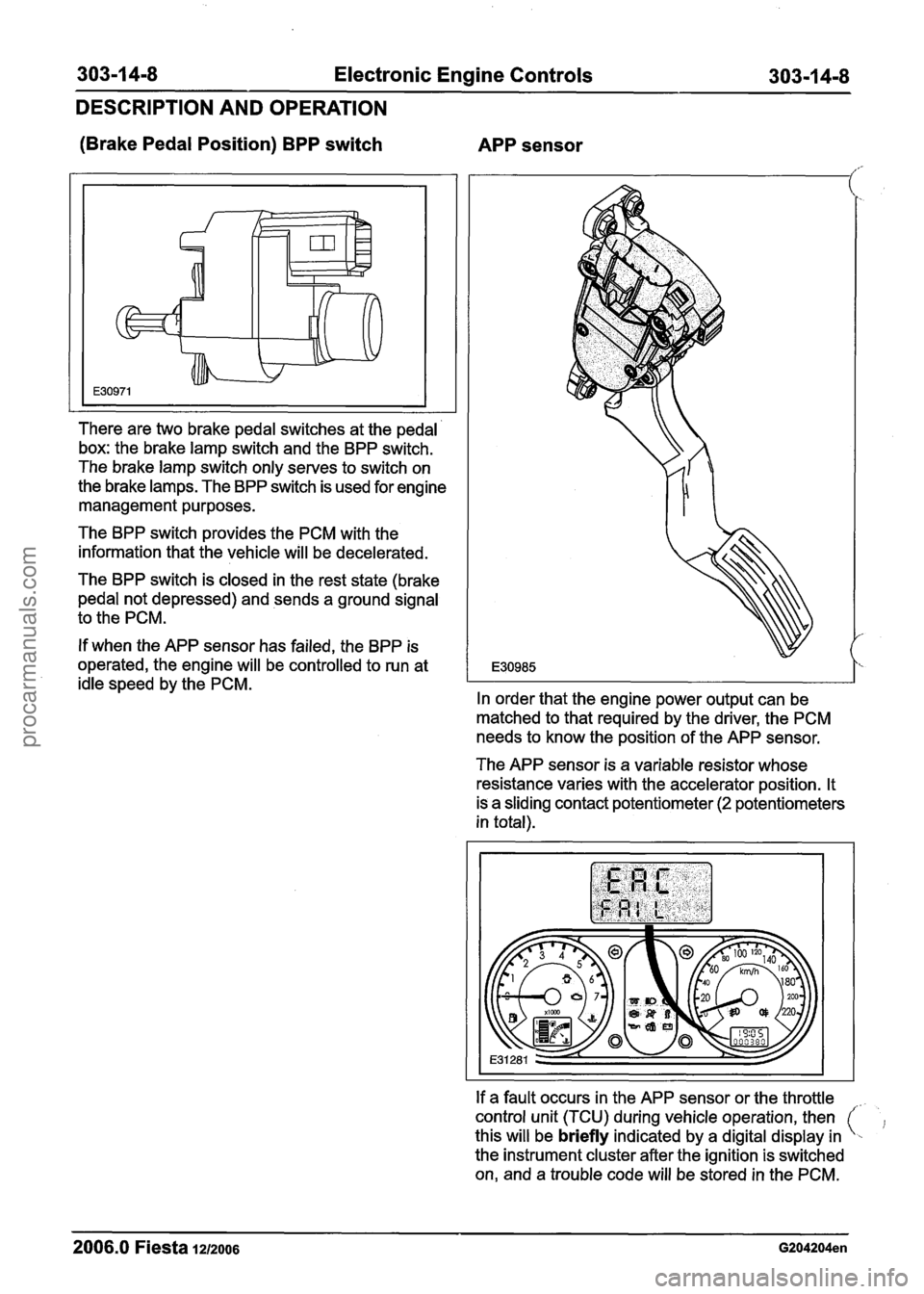
Electronic Engine Controls
DESCRIPTION AND OPERATION
(Brake Pedal Position) BPP switch
APP sensor
There are two brake pedal switches at the pedal
box: the brake lamp switch and the BPP switch.
The brake lamp switch only serves to switch on
the brake lamps. The BPP switch is used for engine
management purposes.
The BPP switch provides the PCM with the
information that the vehicle will be decelerated.
The BPP switch is closed in the rest state (brake
pedal not depressed) and sends a ground signal
to the PCM.
If when the APP sensor has failed, the BPP is
operated, the engine will be controlled to run at
idle speed by the PCM.
In order that the engine power output can be
matched to that required by the driver, the PCM
needs to know the position of the APP sensor.
The APP sensor is a variable resistor whose
resistance varies with the accelerator position. It
is a sliding contact potentiometer
(2 potentiometers
in total).
If a fault occurs in the APP sensor or the throttle
control unit (TCU) during vehicle operation, then
this will be
briefly indicated by a digital display in
the instrument cluster after the ignition is switched
on, and a trouble code will be stored in the PCM.
2006.0 Fiesta 1212006 G204204en
procarmanuals.com
Page 935 of 1226
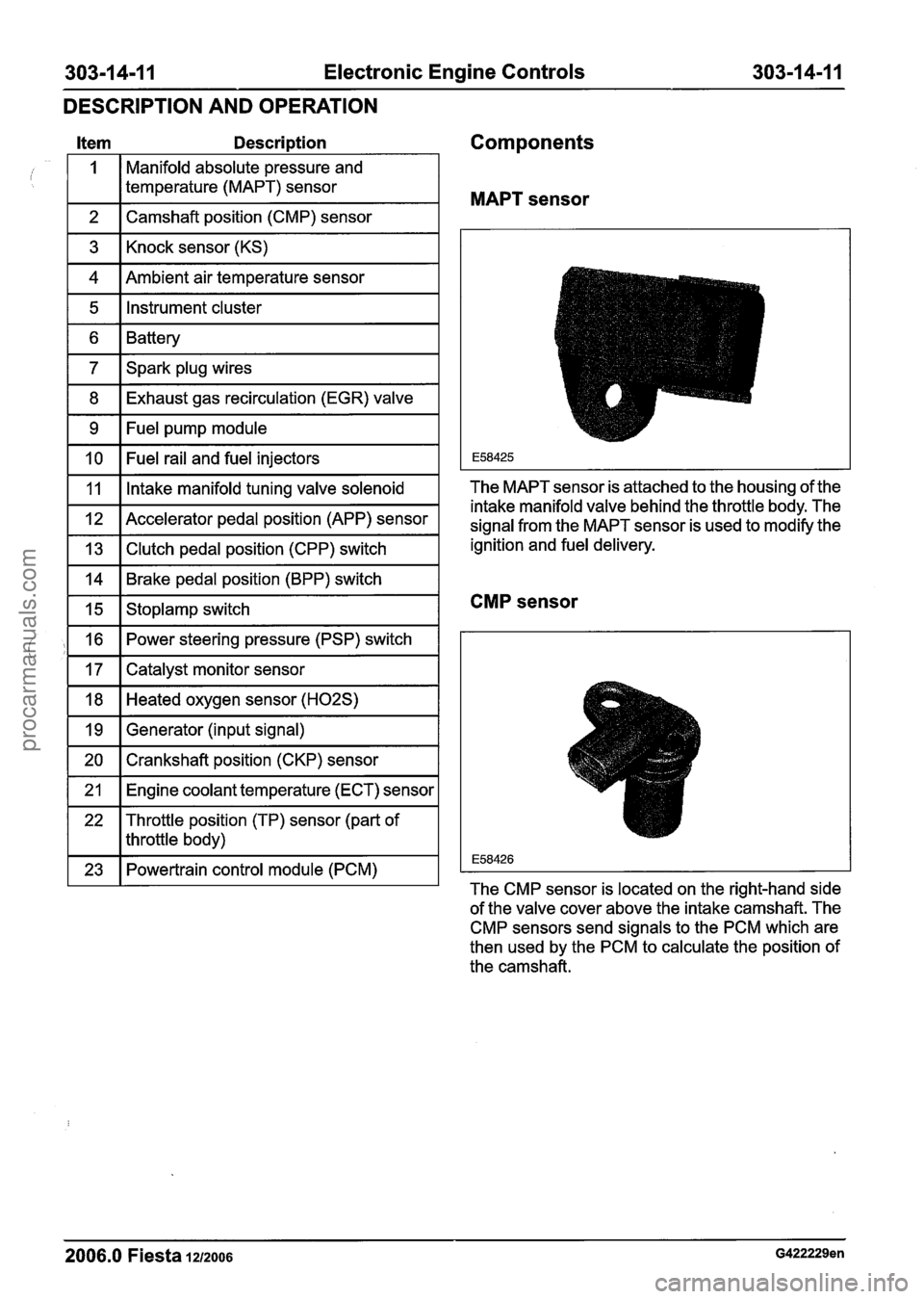
303-1 4-1 1 Electronic Engine Controls 303-1 4-1 I
DESCRIPTION AND OPERATION
Item Description Components
MAPT sensor
Manifold absolute pressure and
temperature (MAPT) sensor
1 2 1 Camshaft position (CMP) sensor I
1 3 1 Knock sensor (KS) I
vl~Ame%air temperature sensor I
1 5 1 Instrument cluster I
1 6 1 Battery I
1 7 1 Spark plug wires I
1 8 1 Exhaust gas recirculation (EGR) valve I
1 9 1 Fuel pump module I
1 10 1 Fuel rail and fuel injectors I
I 11 I Intake manifold tuning valve solenoid The
MAPT sensor is attached to the housing of the
intake manifold valve behind the throttle body. The
signal from the MAPT sensor is used to modify the
ignition and fuel delivery.
1 12 1 Accelerator pedal position (APP) sensor
1 13 1 Clutch pedal position (CPP) switch
1 14 1 Brake pedal position (BPP) switch
CMP sensor 1 15 1 Stoplamp switch
1 16 1 Power steering pressure (PSP) switch I
1 17 1 Catalyst monitor sensor I
FIGted oxygen sensor (H02S) I
1 19 1 Generator (input signal) I
1 20 1 Crankshaft position (CKP) sensor I
1 21 1 Engine coolant temperature (ECT) sensor I
22 Throttle position
(TP) sensor (part of
I I throttle body)
1 23 1 Powertrain control module (PCM) I The CMP sensor is located on the right-hand side
of the valve cover above the intake camshaft. The
CMP sensors send signals to the PCM which are
then used by the PCM to calculate the position of
the camshaft.
2006.0 Fiesta 1212006 G422229en
procarmanuals.com
Page 936 of 1226
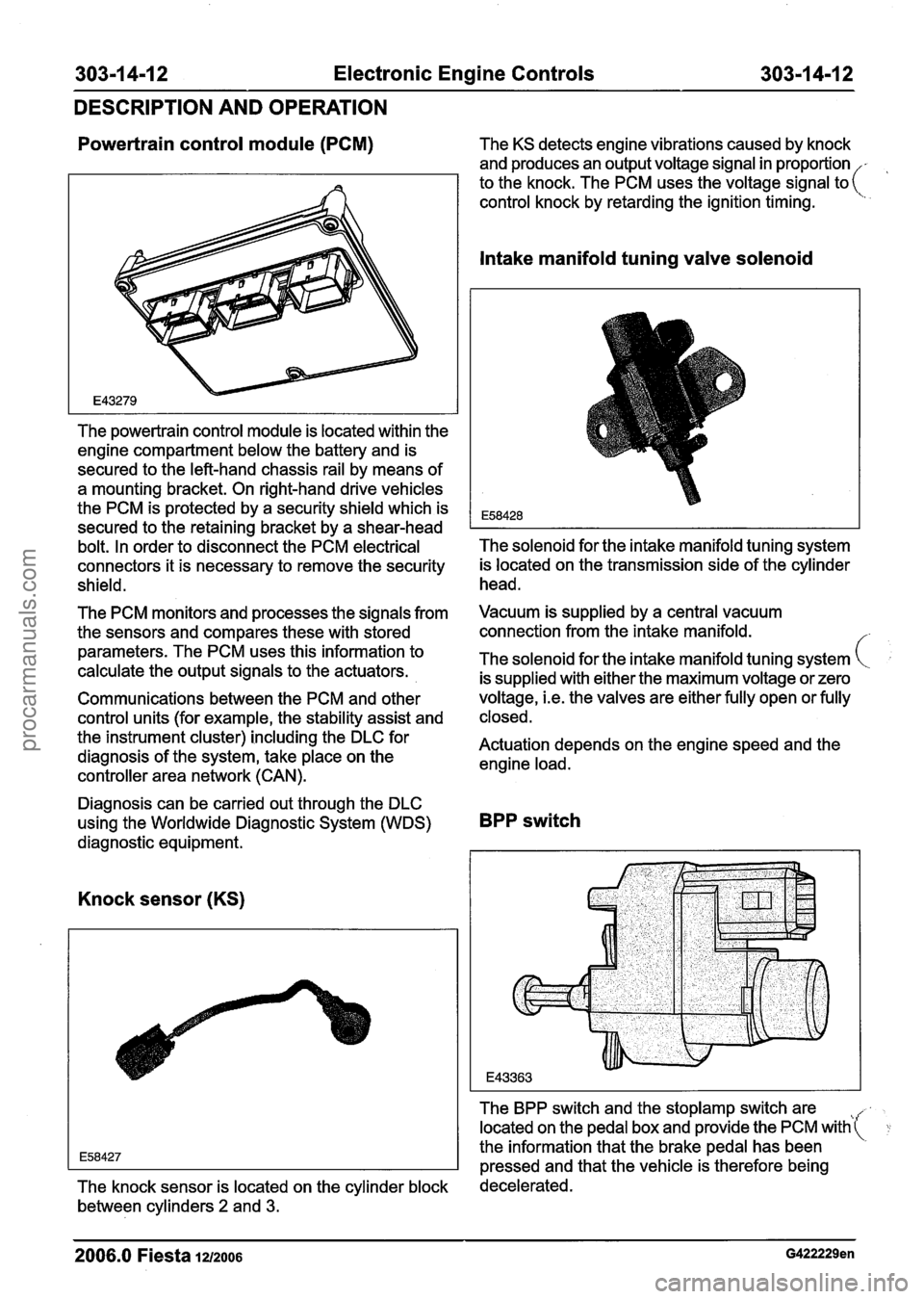
303-1 4-1 2 Electronic Engine Controls 303-1 4-1 2
DESCRIPTION AND OPERATION
Powertrain control module (PCM) The KS detects engine vibrations caused by knock
and produces an output voltage signal in proportion
, to the knock. The PCM uses the voltage signal to(
control knock by retarding the ignition timing.
The powertrain control module is located within the
engine compartment below the battery and is
secured to the left-hand chassis rail by means of
a mounting bracket. On right-hand drive vehicles
the PCM is protected by a security shield which is
secured to the retaining bracket by a shear-head
bolt. In order to disconnect the PCM electrical
connectors it is necessary to remove the security
shield.
The PCM monitors and processes the signals from
the sensors and compares these with stored
parameters. The PCM uses this information to
calculate the output signals to the actuators.
Communications between the PCM and other
control units (for example, the stability assist and
the instrument cluster) including the DLC for
diagnosis of the system, take place on the
controller area network (CAN).
Intake manifold tuning valve solenoid
The solenoid for the intake manifold tuning system
is located on the transmission side of the cylinder
head.
Vacuum is supplied by a central vacuum
connection from the intake manifold.
The solenoid for the intake manifold tuning system
is supplied with either the maximum voltage or zero
voltage,
i.e. the valves are either fully open or fully
closed.
Actuation depends on the engine speed and the
engine load.
Diagnosis can be carried out through the DLC
using the Worldwide Diagnostic System (WDS)
BPP switch
diagnostic equipment.
Knock sensor (KS)
The BPP switch and the stoplamp switch are tt(r located on the pedal box and provide the PCM with
the information that the brake pedal has been
pressed and that the vehicle is therefore being
The knock sensor is located on the cylinder block decelerated.
between cylinders
2 and 3.
2006.0 Fiesta 1212006 G422229en
procarmanuals.com
Page 937 of 1226
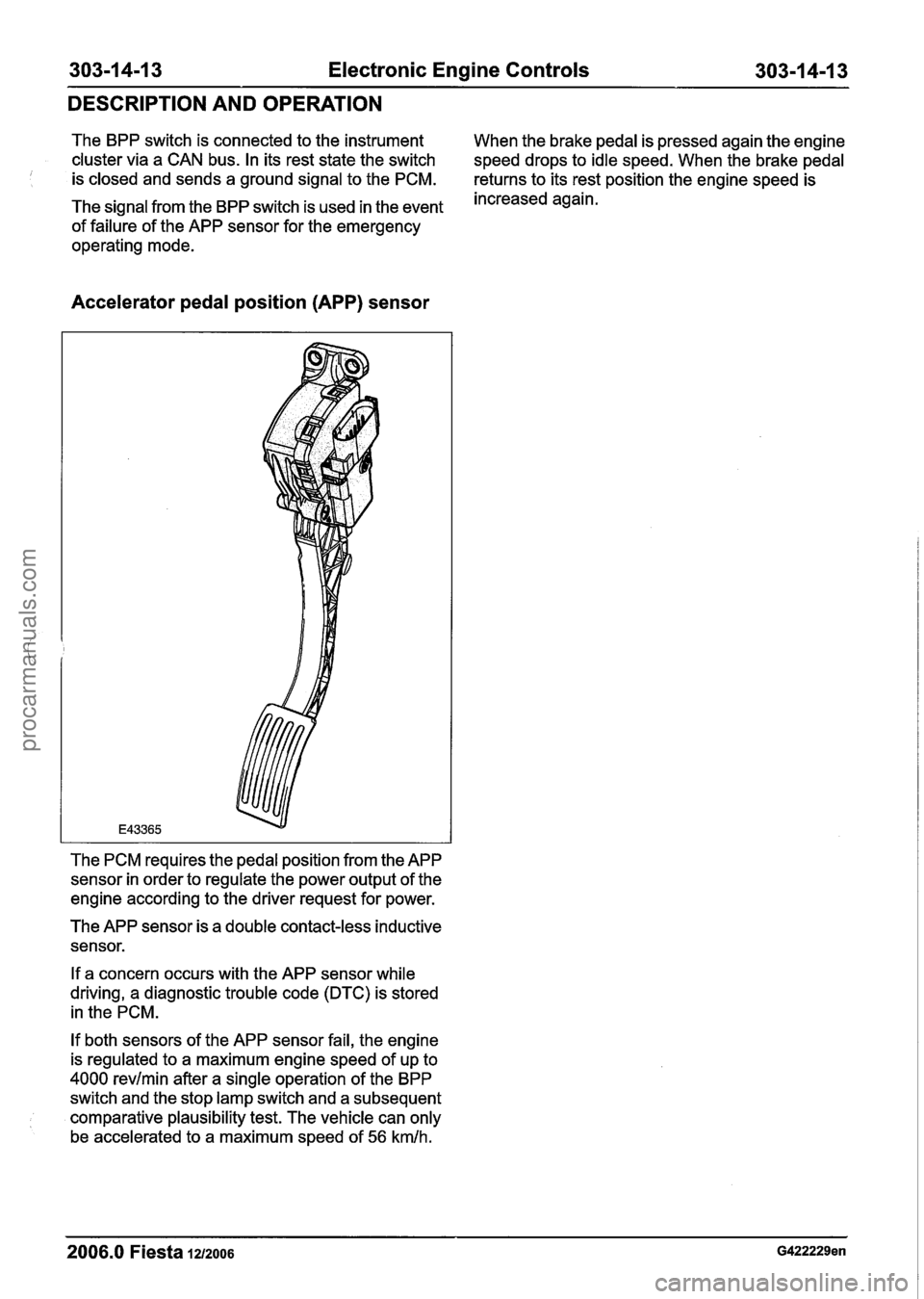
303-1 4-1 3 Electronic Engine Controls 303-1 4-1 3
DESCRIPTION AND OPERATION
The BPP switch is connected to the instrument
When the brake pedal is pressed again the engine
cluster via a CAN bus. In its rest state the switch
speed drops to idle speed. When the brake pedal
is closed and sends a ground signal to the PCM.
returns to its rest position the engine speed is
The signal from the BPP switch is used in the event increased again.
of failure of the APP sensor for the emergency
operating mode.
Accelerator pedal position (APP) sensor
The PCM requires the pedal position from the APP
sensor in order to regulate the power output of the
engine according to the driver request for power.
The APP sensor is a double contact-less inductive
sensor.
If a concern occurs with the APP sensor while
driving, a diagnostic trouble code
(DTC) is stored
in the PCM.
If both sensors of the APP sensor fail, the engine
is regulated to a maximum engine speed of up to
4000 revlmin after a single operation of the BPP
switch and the stop lamp switch and a subsequent
comparative plausibility test. The vehicle can only
be accelerated to a maximum speed of
56 kmlh.
2006.0 Fiesta 1212006 G422229en
procarmanuals.com
Page 938 of 1226
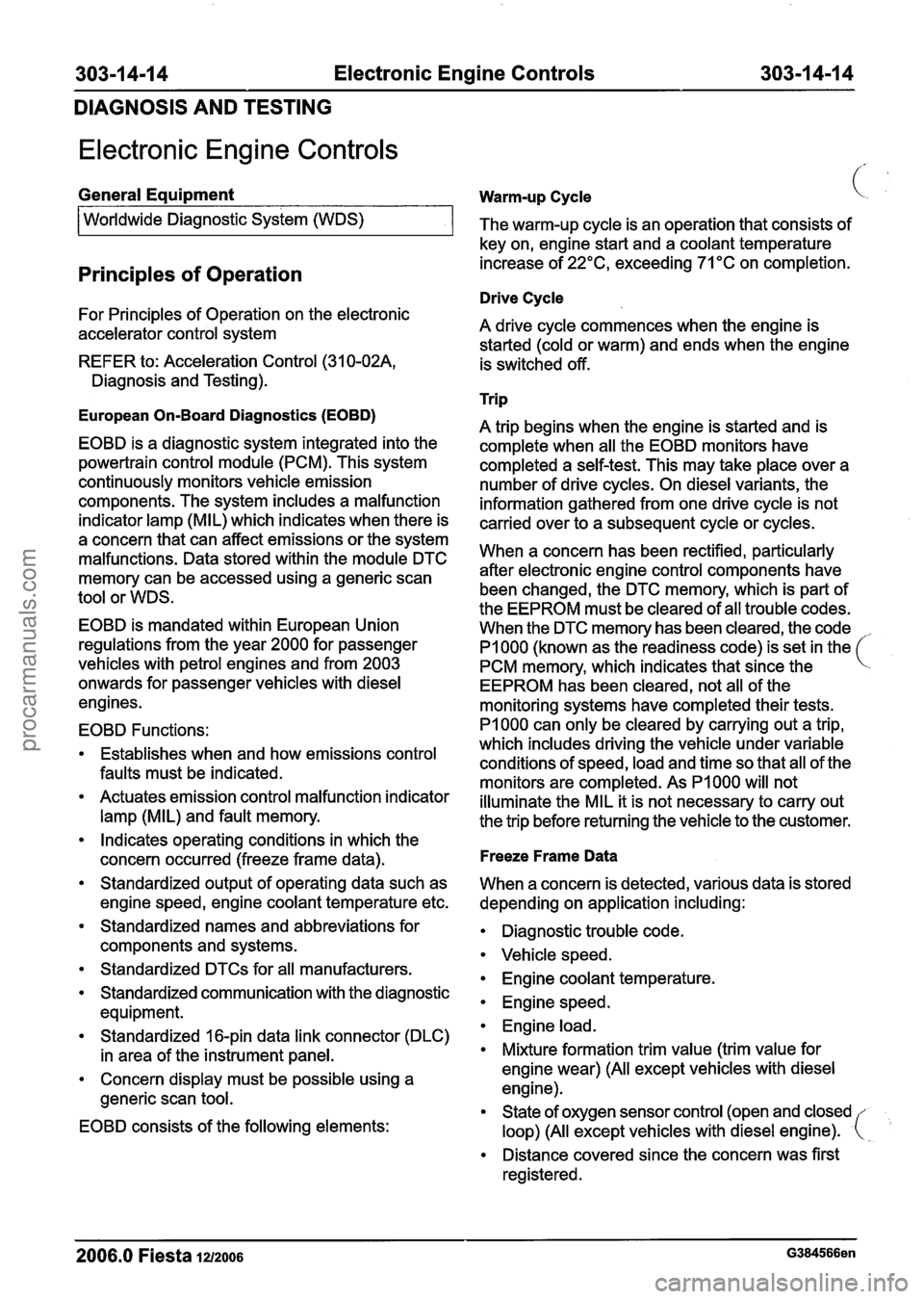
303-1 4-1 4 Electronic Engine Controls 303-1 4-1 4
DIAGNOSIS AND TESTING
Electronic Engine Controls
General Equipment
I Worldwide Diagnostic system (WDS)
Principles of Operation
For Principles of Operation on the electronic
accelerator control system
REFER to: Acceleration Control (31
0-02A,
Diagnosis and Testing).
European On-Board Diagnostics (EOBD)
EOBD is a diagnostic system integrated into the
powertrain control module (PCM). This system
continuously monitors vehicle emission
components. The system includes a malfunction
indicator lamp (MIL) which indicates when there is
a concern that can affect emissions or the system
malfunctions. Data stored within the module DTC
memory can be accessed using a generic scan
tool or WDS.
EOBD is mandated within European Union
regulations from the year 2000 for passenger
vehicles with petrol engines and from 2003 onwards for passenger vehicles with diesel
engines.
EOBD Functions:
Establishes when and how emissions control
faults must be indicated.
Actuates emission control malfunction indicator
lamp (MIL) and fault memory.
Indicates operating conditions in which the
concern occurred (freeze frame data).
Standardized output of operating data such as
engine speed, engine coolant temperature etc.
Standardized names and abbreviations for
components and systems.
Standardized
DTCs for all manufacturers.
Standardized communication with the diagnostic
equipment.
Standardized 16-pin data link connector (DLC)
in area of the instrument panel.
Concern display must be possible using a
generic scan tool.
EOBD consists of the following elements:
Warm-up Cycle C'
The warm-up cycle is an operation that consists of
key on, engine start and a coolant temperature
increase of
22"C, exceeding 71 OC on completion.
Drive Cycle
A drive cycle commences when the engine is
started (cold or warm) and ends when the engine
is switched off.
Trip
A trip begins when the engine is started and is
complete when all the EOBD monitors have
completed a self-test. This may take place over a
number of drive cycles. On diesel variants, the
information gathered from one drive cycle is not
carried over to a subsequent cycle or cycles.
When a concern has been rectified, particularly
after electronic engine control components have
been changed, the DTC memory, which is part of
the EEPROM must be cleared of all trouble codes.
When the DTC memory has been cleared, the code
.
PI000 (known as the readiness code) is set in the
PCM memory, which indicates that since the
EEPROM has been cleared, not all of the
monitoring systems have completed their tests.
PI000 can only be cleared by carrying out a trip,
which includes driving the vehicle under variable
conditions of speed, load and time so that all of the
monitors are completed. As
PI000 will not
illuminate the MIL it is not necessary to carry out
the trip before returning the vehicle to the customer.
Freeze Frame Data
When a concern is detected, various data is stored
depending on application including:
Diagnostic trouble code.
Vehicle speed.
Engine coolant temperature.
Engine speed.
Engine load.
Mixture formation trim value (trim value for
engine wear) (All except vehicles with diesel
engine).
State of oxygen sensor control (open and closed
loop) (All except vehicles with diesel engine).
Distance covered since the concern was first
registered.
2006.0 Fiesta 1212006 G384566en
procarmanuals.com